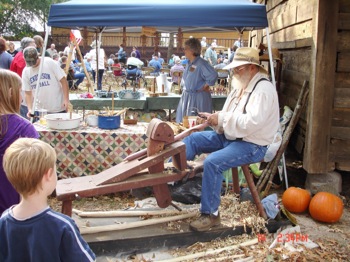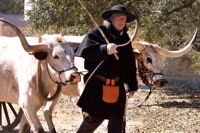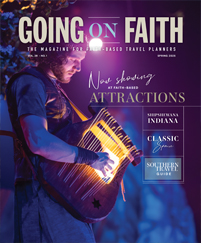
Texas is its own thing, its own place, with its own identity. Texas is not part of the South, nor is it part of the West. Texas is simply Texas.
Spend a little time in Texas, and you’ll begin to understand how the sheer size and rugged individuality of the Lone Star State make it unlike any other place in the country. Spend some more time there, and you’ll discover that much of the state’s characteristic flavor comes from the smaller towns that lie miles away from metropolises like Dallas, Houston and San Antonio.
Texas’ small and midsize towns are home to some of the state’s most important sites. From the place where Texas was born near Brenham to the birthplace of Dr Pepper in Waco, Texas towns offer a glimpse into the stories, characters and events that have made the state what it is today.
On your next group tour of Texas, make some time in your itinerary to visit some of these distinctly Texan sites.
Washington on the Brazos State Historic Site
Washington
Just outside the town of Brenham, the Washington on the Brazos State Historic Site marks the place where representatives from throughout Texas met in 1836 to declare their independence from Mexico.
“We proudly call ourselves the birthplace of Texas,” said the site’s Janice Campbell. “Our town wasn’t a whole lot in 1836. Our hotel was a rectangular log cabin with a dirt floor.”
 |
| Courtesy Washington on the Brazos State Historic Site |
When Davy Crockett and other Texas founders gathered in 1836, they chose this tiny town on the banks of the Brazos River because it was far away from the threat of Santa Ana’s armies in San Antonio, and they met in an unfinished building offered to them by a local gunsmith. Today, visitors to the site can see a re-creation of this historic building, now called Independence Hall. Guides tell about the series of events that led Texas to secede from Mexico and eventually join the United States.
Another component of the site, the Barrington Living History Farm, is a representation of the farm owned by the last president of the Republic of Texas. A farmhouse and a number of barns and outbuildings represent the sort of facilities that a 19th-century Texas farm family would have used, and interpreters still work the farm to demonstrate period life for visitors.
“We work this farm, plant the corn, butcher the hogs and cook the food,” said domestic interpreter Pam Skaggs. “We start the fire in the morning and usually get our meal cooked by noon. We cook a lot of pork, a lot of corn and a lot of potatoes.”
Also part of the site is the Star of the Republic Museum, which features historic artifacts from the various stages of Texas’ past.
www.birthplaceoftexas.com
National Museum of the Pacific War
Fredericksburg
Most tourists know Fredericksburg as a charming 19th-century town with great shopping and a thriving German heritage. Less known is that Fredericksburg was the hometown of admiral Chester Nimitz, who commanded the Allied forces in the Pacific during World War II. Today, the National Museum of the Pacific War in Fredericksburg honors both Nimitz and the people who served alongside him in the war.
“The National Museum of the Pacific War is the only facility in the continental United States that tells the complete story of the war in the Pacific,” said Tom Vortmann, the museum’s director of marketing. “Admiral Nimitz asked that it would be dedicated not just to him but to the men and women who served in his command.”
The museum was originally housed in the hotel that Nimitz’s family owned in Fredericksburg and over the years expanded to include several buildings on a 6-acre campus. One of the key buildings, the George Bush Gallery, was recently expanded and reopened in December.
“It’s now a 33,000-square-foot exhibit that takes us from before Pearl Harbor to see the conflict between Japan, China and the U.S. in the years before the war,” Vortmann said. “It’s a totally different story, with Japan’s aggression and desire to take over territory in the Pacific.”
Among key artifacts in the expanded gallery is one of five “midget submarines,” two-man submersibles that the Japanese deployed as part of the attack on Pearl Harbor. Other exhibits highlight items such as large naval aircraft and the more than 3,500 oral histories collected by the museum staff.
“The whole museum experience culminates with an actual casing that was used in the A-bombs that were dropped over Japan,” Vortmann said. “This would have been the third or the fifth to be used, if the emperor of Japan had not surrendered.”
www.nimitz-museum.org
Spindletop-Gladys City Boomtown Museum
Beaumont
At the beginning of the 20th century, the discovery of oil became one of the strongest driving forces in the growth of Texas. The Spindletop-Gladys City Boomtown Museum shows how the “black gold” caused new settlements to spring up quite quickly.
“Our museum is a re-creation of the original oil boomtown called Gladys City,” said Christy Marino, the museum’s curator. “It sprang up after the discovery of an oil gusher called Spindletop in 1901. It was the site of the very first oil gusher in the United States, and overnight, people started swarming to Beaumont.”
The museum was created in 1975 by Lamar University, and today, it has about 15 replicas of various business that sprang up around the oil boom. These include a general store, a saloon, a post office and a doctor’s office. But unlike other historic villages with beautiful, ornate buildings, these shops and offices are unadorned structures, representing the haste with which Gladys City was built.
“Because they were built very quickly, they were basic buildings with the bare necessities,” Marino said. “They were called clapboard buildings, and they weren’t even painted.”
For groups, a highlight of the visit is the 64-foot-high oil derrick that can be used for a re-created oil gusher.
“It replicates the actual oil gusher from 1901,” Marino said. “It blows water 150 feet in the air. We call it the only working replica oil gusher in the world.”
Ocean Star Offshore Drilling Rig and Museum
Galveston
On Texas’ Gulf Coast, the offshore oil industry has become an important part of the state’s economy. In Galveston, groups can learn about life on board a water-bound oil rig at the Ocean Star Offshore Drilling Rig and Museum.
 |
| Courtesy Ocean Star Museum |
“We took a retired drilling rig that had been sitting in a shipyard and turned it into a museum,” said Lisa Lisinicchia, the museum’s operations director. “We talk about finding oil, drilling it and producing it and how all these things happen out in the water. We’ve got models and equipment running the whole gamut.”
The Ocean Star is a 1960s oil rig that drilled some 250 wells during its time in service. The rig is now permanently jacked up in the gulf, although it is connected to the shore by a 400-foot pedestrian bridge. Although the rig is taller than the Statue of Liberty, it is still much smaller than some of the rigs in service today.
While onboard, visitors will see various displays that deal with life and work on an offshore rig.
“The inside of the museum is chronological,” Lisinicchia said. “We talk about the geology, how you look for oil and gas, and how you drill down to it. You can go out onto the pipe deck or walk across a bridge down to the drilling floor.”
Groups can arrange to have a docent-guided tour of the rig or go around on their own with the help of handheld audio guides.
Heritage Syrup Festival
Henderson
In the east Texas town of Henderson, the annual Heritage Syrup Festival has grown to attract more than 30,000 visitors each year. The event was born 21 years ago when the local Depot Museum acquired a historic syrup mill for its collection.
“The museum had a syrup mill, and they wanted to bring tourism into Henderson, so they got together and decided to put on a syrup festival,” said Vickie Armstrong, director of the Depot Museum. “After the first year, the people decided to make it bigger and bigger, so we have about 40 folk artists set up at the museum, along with food vendors.”
The product at the heart of the festival is ribbon cane syrup, a sweetener made from the ribbon sugar cane grown in the area. Locals use it on biscuits, pancakes and other foods to add sweetness and flavor. During the festival, visitors can see teams of volunteers using the historic mill to press the cane and cook it down to syrup, and they can then taste the syrup on various foods sold by the vendors.
The festivities have grown beyond the exhibit, extending into downtown Henderson with craft vendors, musicians and more.
“We have bluegrass and country music, and this year we’re having a ’60s rock ’n’ roll band,” said Suzanne Cross, tourism coordinator for the city of Henderson. “We also have antique and classic car exhibits. This year, we had 147 antique and classic cars.”
The festival takes place every year on the second Saturday of November. This year’s festival will be held Nov. 13.
www.depotmuseum.com
Dr Pepper Museum
Waco
Everywhere you go in Texas, restaurants, bars and stores serve Dr Pepper, a soft drink that was formulated in Waco and eventually took off across the country. Tour groups spending time in Waco can see the origins of the sweet and spicy drink at the Dr Pepper Museum.
 |
| Courtesy Dr Pepper Museum |
“Dr Pepper is the oldest soft drink on the market today,” said Jennie Sheppard, director of communications at the museum. “It was invented by a man who worked at a pharmacy here in Waco in 1885. The Dr Pepper Museum is housed in the Artesian Manufacturing and Bottling Co. building from 1906.”
It was in this building that the soft drink was first bottled for mass production, using water from an artesian well inside. Today, visitors begin their tour in a room of the museum that has been converted to re-create the soda fountain at the corner drug store where the drink was first formulated.
Next on the tour is the 27-foot-deep well that supplied water for the plant, as well as some of the early bottling equipment, labels and packaging that were used to produce and distribute Dr Pepper. Other exhibits feature artifacts from the museum’s 30,000-item collection, which include memorabilia from Dr Pepper and other American soft drink makers.
In addition to checking out the exhibits, groups can participate in a number of interactive and behind-the-scenes tours at the museum. One of the favorites is the Create a Soft Drink experience.
“Groups come in, do a tour of the museum and then get to make their own soft drinks,” Sheppard said. “They get different fruit syrup flavors, combine them and make their own soft drinks, then create a label and bottle it. Afterward, they can come downstairs and have a float.”










